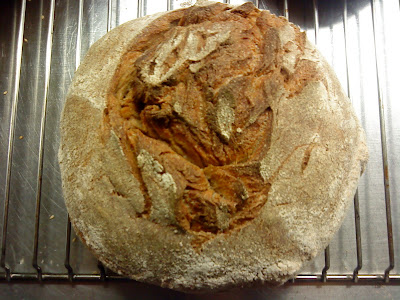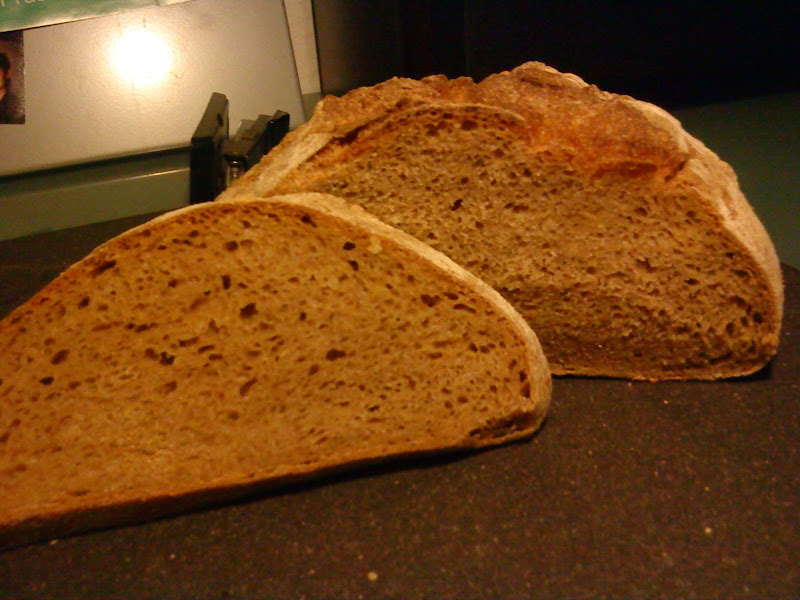I undigged an old and beloved recipe, which I somehow just didn't bake in the last time. It's a rather simple recipe; I got it from a woman originating from South Tyrol, she calls it her Farmerbread (Bauernbrot). It's a sourdough bread which can be altered fairly much.
This time I used only whole-grain flours, although the recipe originally asks for high extraction flour (partly).
I posted the recipe for the first time here in my very first forum post when I was asked to share some of my favourite recipes.
The recipe below is how I did yesterday.
The resulting bread remains one of my favourites, it has a fully developed flavour, is pleasantly "heavy", moist, somewhat chewy. Perfect for a hearty sandwich, for instance with a strong cheese or ham. My today's sandwich is made with this bread, a bean spread, cucumber and radish slices. Yum!
the lady of South Tyrol told me that she alters the recipe according to what she's got on hand, sometimes she increases the rye percentage, sometimes she makes it completely wheat. She reccomends to add 150 g of walnuts as well, but this amount seems to be fairly little to me. but I've never tried it yet. I could imagine that a toasted seed-soaker (especially sunflower seeds, flaxseeds...) would work outstandingly.
Bauernbrot
(Farmerbread)
------------
(1) "Preferment"
250 g whole grain rye flour
250 ml water
200 g ready to bake sourdough (100% hydration whole grain rye)
(2) final dough
1 kg whole-wheat flour (original: 500 g whole-wheat rye, 500 g high extraction wheat flour)
750 ml lukewarm water
27 g salt
1 tablespoon honey
3 tbs Vital Wheat gluten (can be excluded)
1. Prepare the sourdough (200 g), let it ripe.
2. Mix all the ingredients of (1) in a bowl ("Preferment"), cover it and let it rest for 12 hours on a warm spot.
I'm sure that the "preferment" could be substituted by a normal whole rye sourdough, without this extra step. Just mix 335 g flour, 335 g water and 30 g ripe culture and let it fully ferment. But this must me quite harder to digest for the yeasties, so if you have time it's maybe worth to feed the dough in two steps.
3. mix this "preferement with all the other ingredients of the final dough. Knead the dough for at least 15 minutes (by hand). This time I added vital wheat gluten, but I didn't feel much of a difference compared to my earlier bakes.
4. for the first fermentation: cover the bowl and let the dough ferment until it feels light, it should slightly less than double. This took me around four hours, but be aware that sourdough can differ a lot depending on dough and room temperature! I had the same recipe fully fermenting in two hours in summer.
5.Shaping
for the baking in pans: grease two or three pans ane it with baking paper. (I don't know how big american pans normally are, so just divide into two or three pieces as you feel)
For baking as hearth loaves: Shape like discussed here (ff)
5. let the loaves rest until they've risen quite a bit (slightly less than doubled, until they feel "light") watch your dough and judge yourself.
6. preheat your oven as hot as possible (450°F) , steam well, put the breads into the oven and lower the temperature to 420°F, lower the temperature gradually during the rest of the bake, ending at around 390°F. I baked for about 50 minutes.
7. Let cool and let the loaf set over night.



Salome